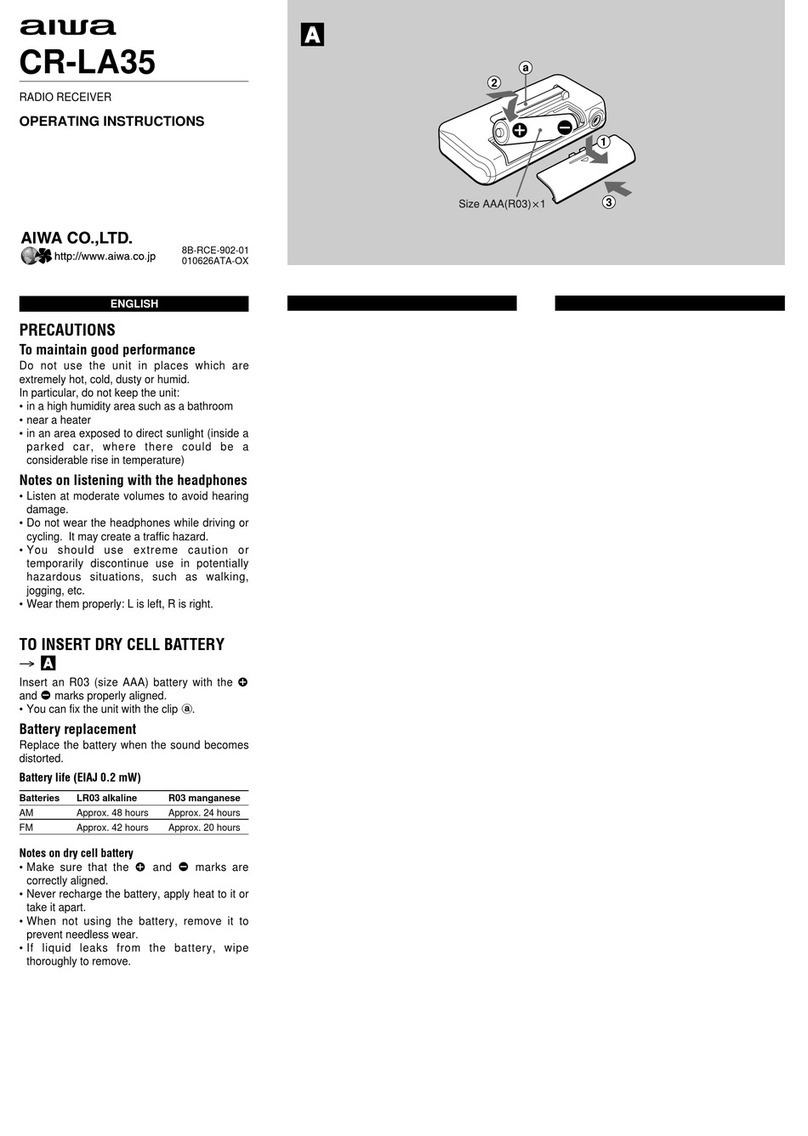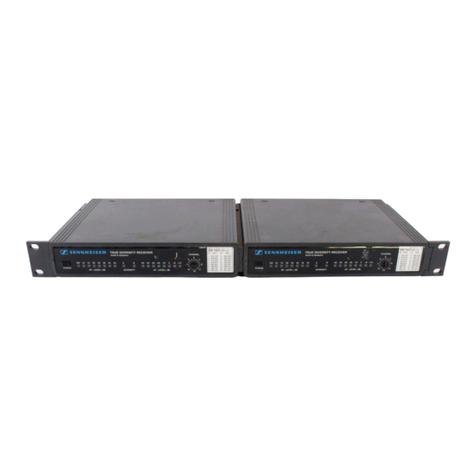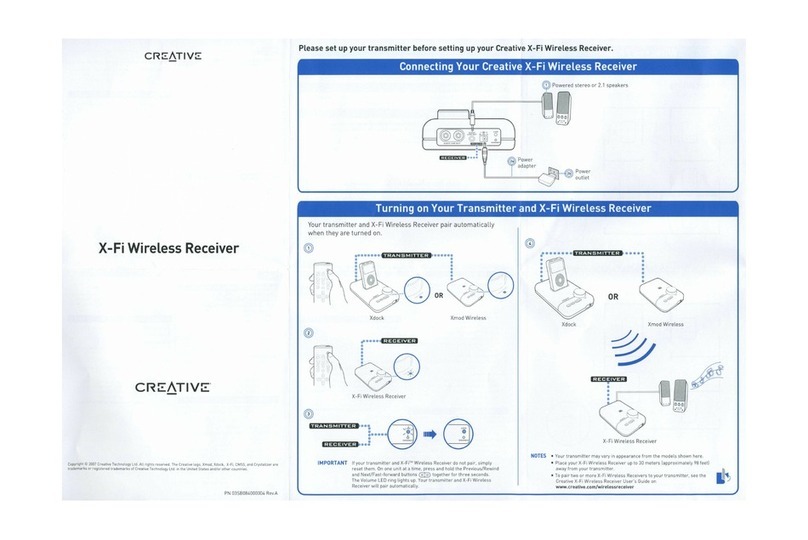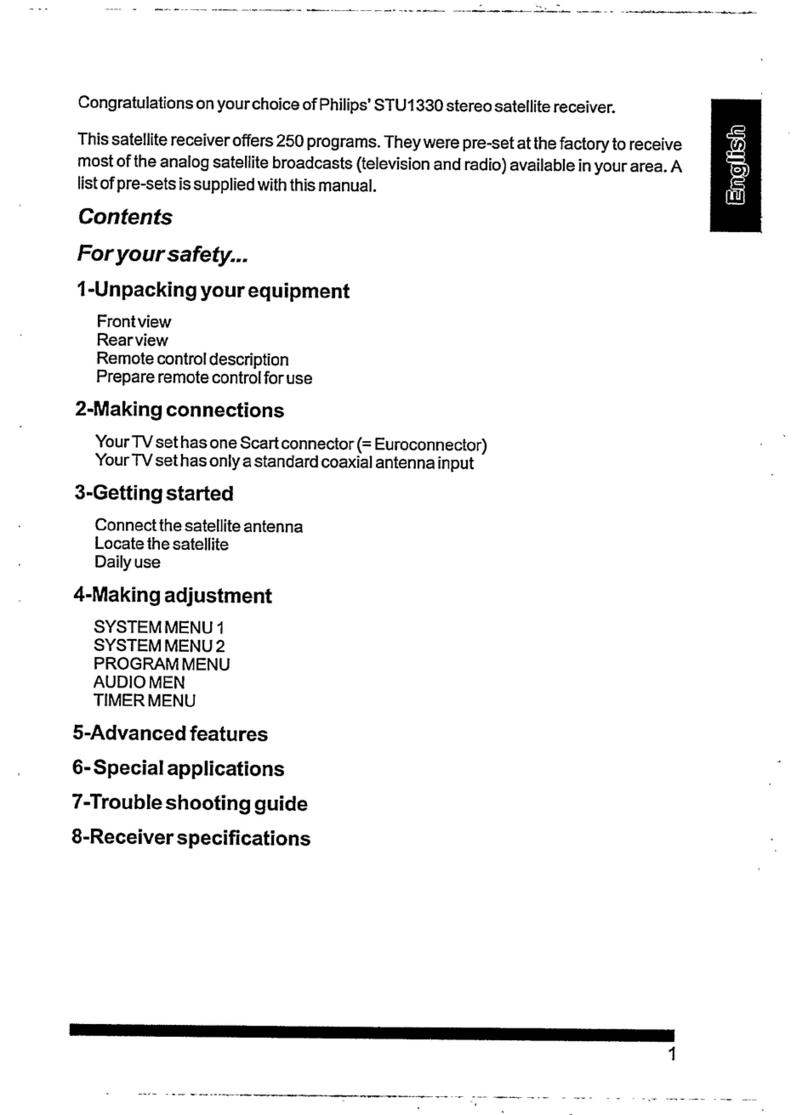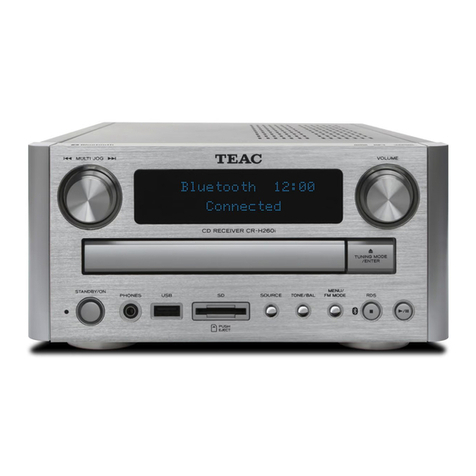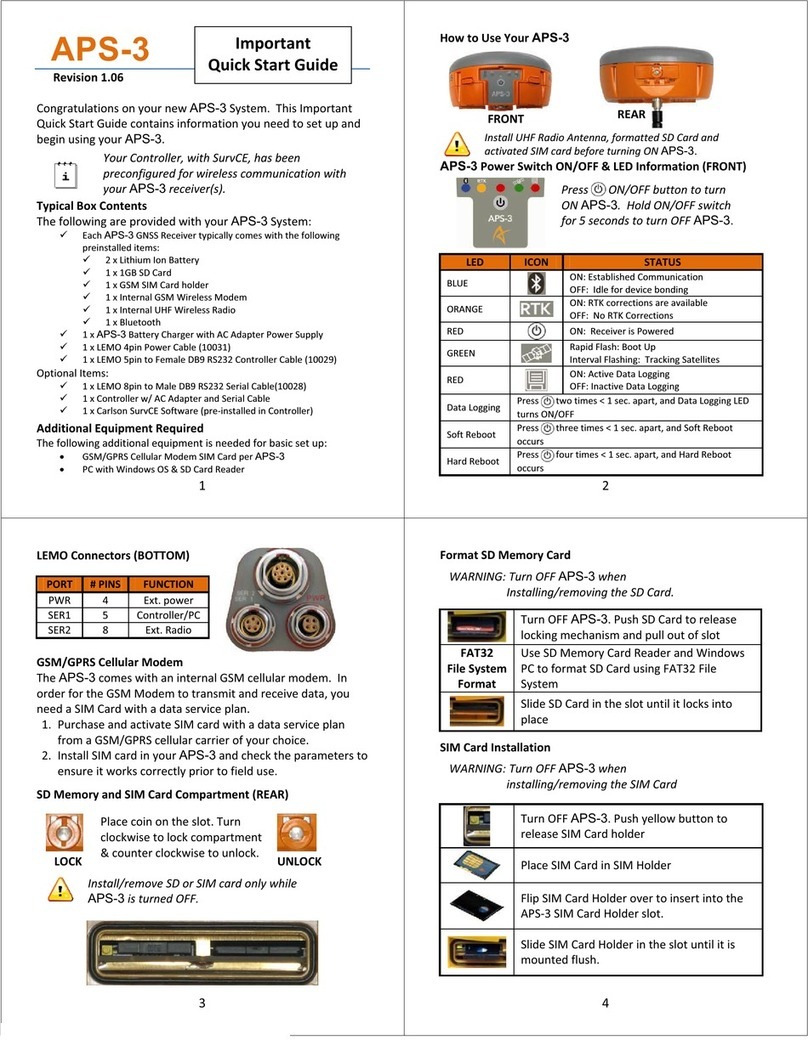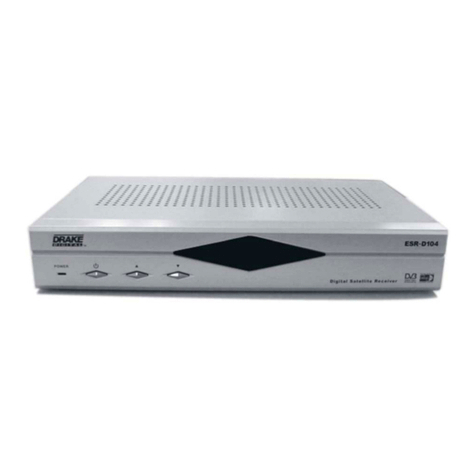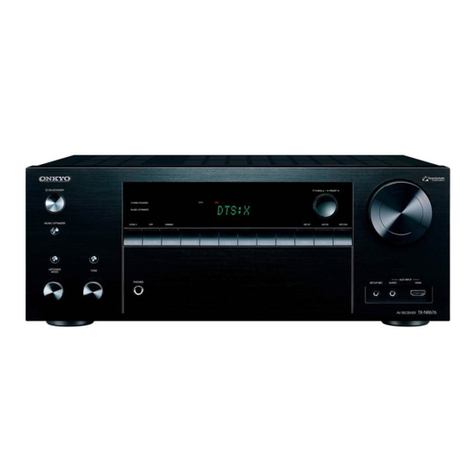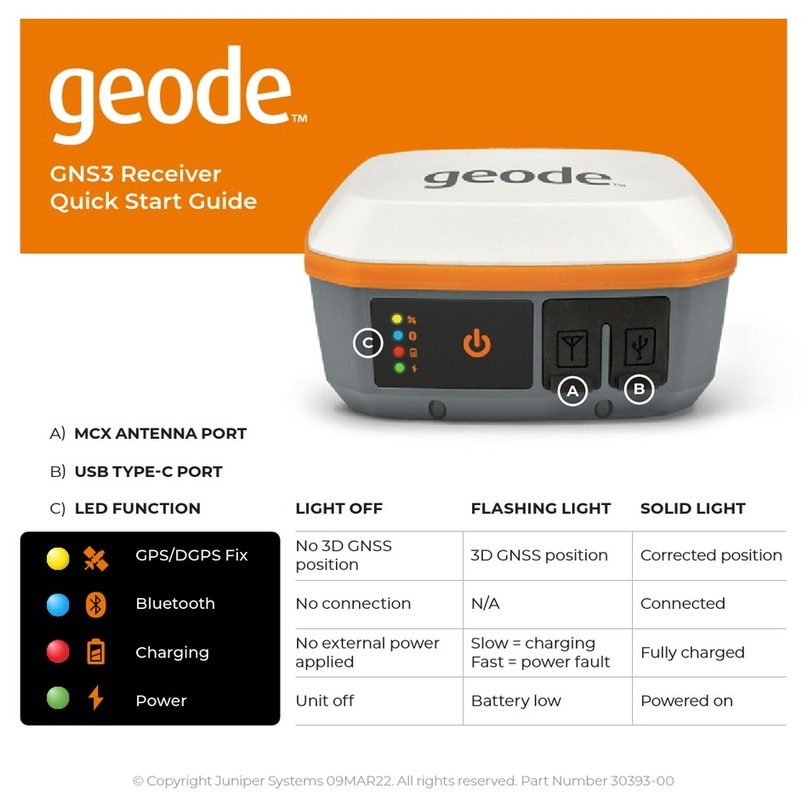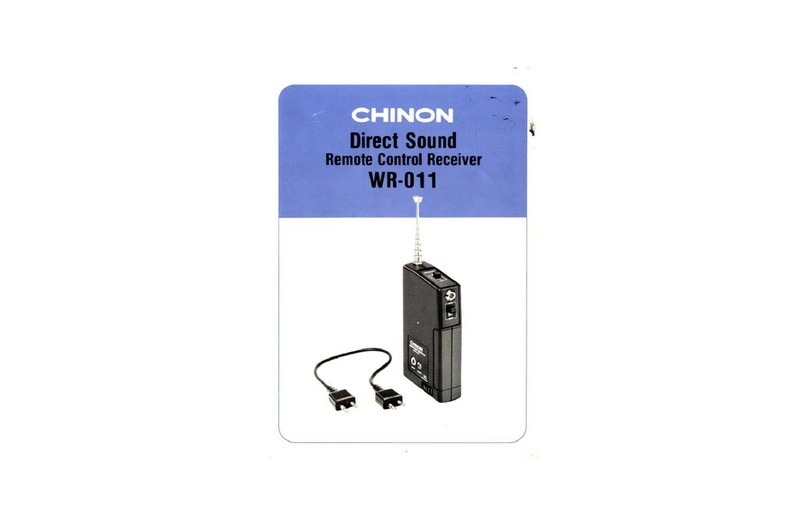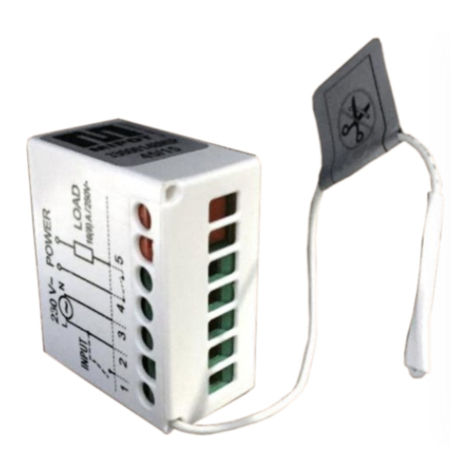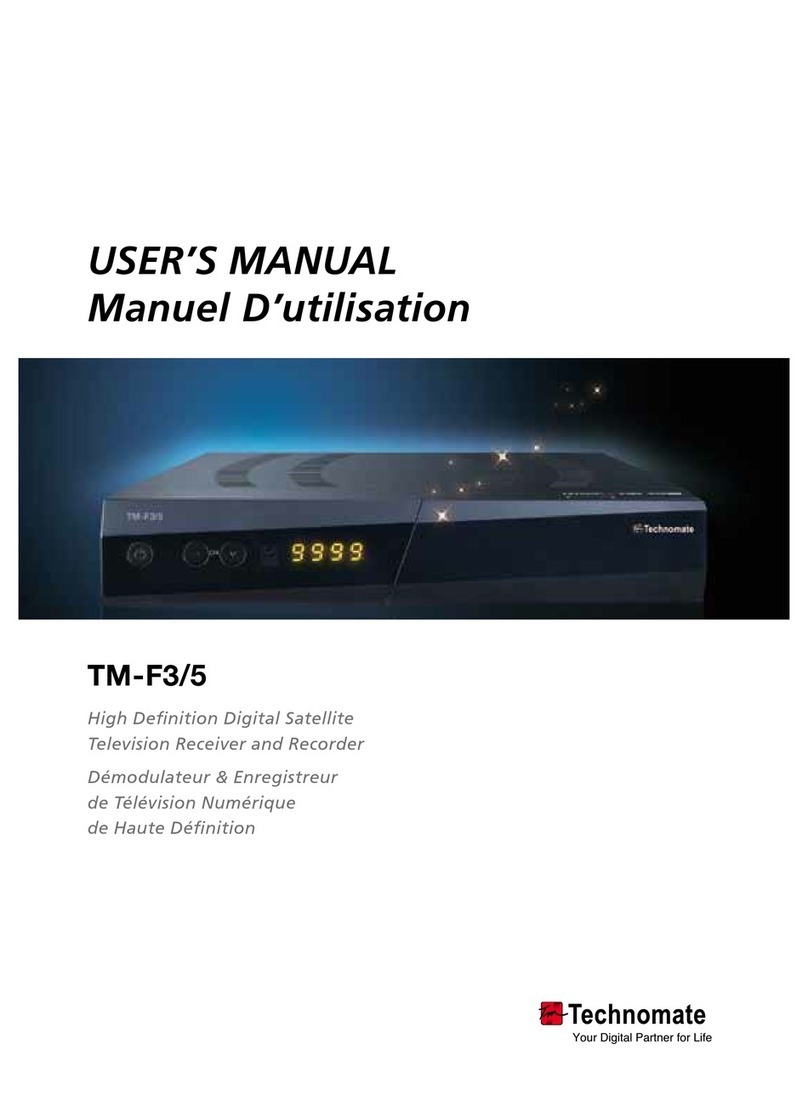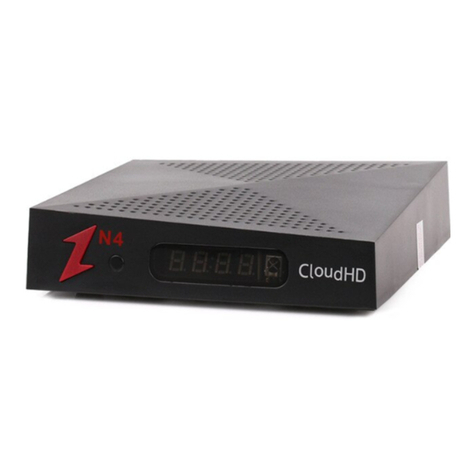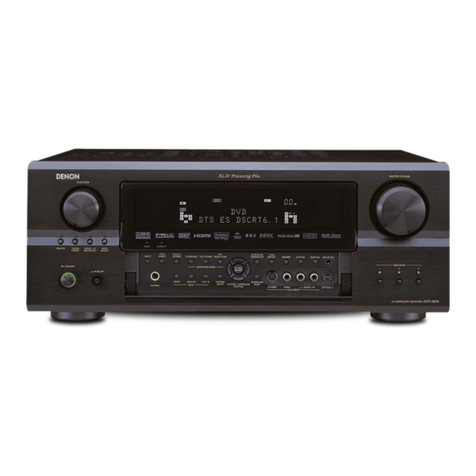Silicon Laboratories Si475X Series Operating instructions

Rev. 0.9 10/16 Copyright © 2016 by Silicon Laboratories AN543
Silicon Laboratories Confidential. Information contained herein is covered under non-disclosure agreement (NDA).
AN543
Si475XPROGRAMMING GUIDE
1. Introduction
This document provides an overview of the programming requirements for the Si475x-A10/A20/A30/A40/A55 and
Si475xC-A55 AM/FM receiver. The hardware control interface and software commands are detailed along with
several examples of the required steps to configure the device for various modes of operation. Table 1 provides a
programming guide cross-reference for each Si475x part released by Silicon Labs to date. This programming guide
focuses on the Si475x/5xC-A55 release; however, features, properties, ranges, and defaults that differ from the
Si475x-A10 to Si475x-A40 are noted as well. Refer to previous versions of this document for earlier firmware
revisions.
2. Overview
This devices in this product family are programmed using commands and responses. To perform an action, the
system controller writes a command byte and associated arguments, which cause the device to execute the given
command. The device will, in turn, provide a response depending on the type of command that was sent.
The device has a slave control interface that allows the system controller to send commands to and receive
responses from the device using 2-wire mode (I2C compatible).
3. Terminology
CTS—Clear to send
STC—Seek/Tune Complete
NVM—Non-volatile internal device memory
Device—Refers to the AM/FM Receiver
System Controller—Refers to the system microcontroller
CMD—Command byte
ARGn—Argument byte (n = 1 to 7)
STATUS—Status byte
RESPn—Response byte (n = 1 to 15)
Table 1. Si475x Firmware Revisions
Part # Part Revision FMRX Component AMRX Component
Si475x-A10 1.0 3.2.3 3.2.3
Si475x-A20 2.0 8.0.8 7.0.5
Si475x-A30 3.0 10.0.8 9.0.6
Si475x-A40 4.0 13.0.11 12.0.10
Si475x-A55 5.5 15.0.2 14.0.1
Si475xC-A55 5.5 15.0.2 14.0.1

AN543
2 Rev. 0.9
4. Control Interface
The Si475x provides an I2C-compatible, 2-wire control interface.
In powerdown mode, all circuitry is disabled except for the device control interface. The device comes out of
powerdown mode when the POWER_UP command is written to the command register. Once in powerup mode,
the device accepts additional commands such as tuning. The device will not accept commands while in
powerdown mode, with the exception of the powerup command. If the system controller writes a command other
than POWER_UP when in powerdown mode, the device does not respond, and the command is ignored.
Setting the RSTB pin low places the device in reset mode. In reset mode, all circuitry is disabled including the
device control interface; registers are set to their default settings, and the control bus is disabled.
4.1. 2-Wire Control Interface
Figure 1 and Figure 2 show the 2-wire control interface read and write timing parameters and diagrams,
respectively. Refer to the Si475x data sheet for timing parameter values.
Figure 1. I2C Control Interface Read and Write Timing Parameters
Figure 2. I2C Control Interface Read and Write Timing Diagram
SCL 70%
30%
SDA 70%
30%
START STARTSTOP
tf:IN
tr:IN
tLOW tHIGH
tHD:STA
tSU:STA tSU:STO
tSP tBUF
tSU:DAT
tr:IN tHD:DAT tf:IN,
tf:OUT
tPD:DAT
SCL
SDA
(Write)
START STOPADDRESS + R/W ACK DATA ACK DATA ACK
A6-A0, 0 Command
7-0 Arg1
7-0
SDA
(Read)
START STOPADDRESS + R/W ACK DATA ACK DATA ACK
A6-A0, 1 Status
7-0 Response
7-0

AN543
Rev. 0.9 3
Two-wire bus mode uses the SCL and SDA pins for signaling. A transaction begins with the START condition,
which occurs when SDA falls while SCL is high. Next, the system controller drives an 8-bit control word serially on
SDA, which is captured by the device on rising edges of SCL. The control word consists of a seven-bit device
address followed by a read/write bit (read = 1, write = 0). The device acknowledges the control word by driving
SDA low on the next falling edge of SCL.
For write operations, the system controller next sends a data byte on SDA, which is captured by the device on
rising edges of SCL. The device acknowledges each data byte by driving SDA low for one cycle on the next falling
edge of SCL. For each write transaction, the first byte is a command and the following bytes are arguments.
For read operations, after the device has acknowledged the control byte, it will drive an eight-bit data byte on SDA,
changing the state of SDA on the falling edges of SCL. The system controller acknowledges each data byte by
driving SDA low for one cycle on the next falling edge of SCL. If a data byte is not acknowledged by the system
controller, the transaction will end. For each read transaction, the first byte is the status byte and the following bytes
are the response data from the receiver.
A 2-wire transaction ends with the STOP condition, which occurs when SDA rises while SCL is high.
5. Powerup and Powerdown
There are two procedures for powering up a receiver to move it from powerdown mode to the powerup mode. The
first is a powerup from internal receiver memory. The second is a powerup from a firmware component patch that is
stored in system controller memory. Patches can be applied to a firmware component by the system controller via
a download mechanism to address field issues, errata, or adjust device behavior. Patches are encrypted and
unique to a particular device firmware version, cannot be generated by customers, and can be used to replace a
portion of the component (to address errata, for example) or to download an entirely new component. The user
must verify that the device contains the correct base firmware to support the patch as described later in this
section.
It has been noted that some crystals require greater startup current and settling times than others. The procedure
below is meant to apply to a wide variety of such crystals, providing maximum current and 40 ms for crystal
oscillation to stabilize. If there are still difficulties with POWER-UP that may be related to your choice of crystal,
please refer to the settings and hardware options in “AN750: Si475x 4 MHz Crystal Compatibility Power-Up
Procedure”.

AN543
4 Rev. 0.9
5.1. Powerup Receiver from Internal Memory
1. Supply VA, VD, and VIO while keeping the RSTB = 0. Power supplies may be sequenced in any order.
2. After a minimum of 100 µs, set RSTB = 1.
3. After a minimum of 100 µs, continue to the next step.
4. Send the POWER_UP command for the desired function (AM, FM).
Supply VA, VD, and VIO while
keeping the RSTB = 0
START
After a minimum of 100 µs,
set RSTB = 1
After a minimum of 100 µs,
continue to the next step
Send second POWER_UP
command for the desired
function (AM, FM)
Commence normal operation
Send POWER_DOWN
command
Send the POWER_UP
command for desired function
(AM, FM)
Wait at least 100 ms
Send command
to force CTS = 1

AN543
Rev. 0.9 5
Example (with crystal 4 MHz, FM function):
1. Provide the initial POWER_UP Command:
2. Apply a wait time of at least 100 ms.
3. Apply the following command:
4. Apply the following command:
Note: For more details on the external circuit for the 4 MHz crystal, see “AN750: Si475x 4 MHz Crystal Circuit and Power-Up
Procedure”.
5. The device is ready to commence normal operation and accept additional commands. Refer to Figure 3.
Action Data Description
CMD 0x01 POWER_UP
ARG1 0X77 NORMAL OPERATION, 4 MHz Crystal
ARG2 0x1F SETS CRYSTAL LOAD CAPACITANCE
Note: Change this value to the capacitance that matches the crystal in use.
ARG3 0x27 SETS CRYSTAL BIAS = 7 w/ FASTBOOT
ARG4 0x00
0x10
0x20
BOOT LOADER
FM Receive, 4 MHz Crystal
AM Receive, 4 MHz Crystal
ARG5 0x00 DIGITAL CORE DISABLED/CRYSTAL OSCILLATOR DISABLED
STATUS NO CTS bit returned
Action Data Description
CMD 0xFB CONTROL REGISTER WRITE COMMAND
ARG1 0X06 CONTROL REGISTER ADDRESS
ARG2 0x80 FORCES CTS = 1
STATUS NO CTS bit returned
Action Data Description
CMD 0x01 POWER_UP
ARG1 0X77 NORMAL OPERATION, 4 MHz Crystal
ARG2 0x1F SETS CRYSTAL LOAD CAPACITANCE
Note: Change this value to the capacitance that matches the crystal in use.
ARG3 0x23 SETS CRYSTAL BIAS = 3 w/ FASTBOOT
ARG4 0x00
0x10
0x20
BOOT LOADER
FM Receive, 4 MHz Crystal
AM Receive, 4 MHz Crystal
ARG5 0x11 DIGITAL CORE ENABLED/CRYSTAL OSCILLATOR ENABLED
STATUS CTS = 1

AN543
6 Rev. 0.9
Figure 3. Powerup Timing
6. If desired, send the POWER_DOWN command.
Example:
7. It is now possible to move to the powerup state by returning to step 4.
POWER_DOWN Command
Action Data Description
CMD 0x11 POWER_DOWN
ARG1 0x00 Disable oscillator (ARG1 may be omitted with the same result)
STATUS →0x80 CTS = 1
VIO
VD
VA
RSTB
SCL
SDA POWER_UP Command
100 µs min
100 µs min
> 10 µs

AN543
Rev. 0.9 7
5.2. Powerup Receiver from a Patch
1. Supply VA, VD, and VI0 while keeping the RSTB = 0. Power supplies may be sequenced in any order.
2. After a minimum of 100 µs, set RSTB = 1.
3. After a minimum of 100 µs, proceed to the next step.
4. (Optional – step 1 of 3 to verify part firmware revision and ROM revision.) Both part firmware revision and ROM
revision must be compatible with a partial patch and ROM revision must be compatible with a full patch. Send
the POWER_UP command for the desired function (AM, FM).
Supply VA, VD, and VIO
while keeping the RSTB = 0
START
After a minimum of 100 µs,
set RSTB = 1
After a minimum of 100 µs,
continue to the next step
Send the POWER_UP
command for the desired
function (AM, FM)
Send POWER_DOWN
command
A
B
Verify Firmware and ROM
revision? A
B
Send PART_INFO command
Wait at least 100 ms
Send second POWER_UP
command for the desired
function (AM, FM)
C
Send the POWER_UP
command with boot loader
function
Send patch data.
Send the POWER_UP
command for the desired
function (AM, FM)
Commence normal operation.
Send POWER_DOWN
command.
Wait at least 100 ms
Send second POWER_UP
command with bootloader
function
B
C
Send command to force
CTS = 1 Send command to force
CTS = 1

AN543
8 Rev. 0.9
Example (with crystal 4 MHz, FM function):
1. Provide the initial POWER_UP Command:
2. Apply a wait time of at least 100 ms.
3. Apply the following command:
4. Apply the following command:
Note: For more details on the external circuit for the 4 MHz crystal, see “AN750: Si475x 4 MHz Crystal Circuit and Power-Up
Procedure”.
5. (Optional – step 2 of 3 to verify part firmware revision and ROM revision). Verify part firmware revision and
ROM revision. Send the PART_INFO command.
Action Data Description
CMD 0x01 POWER_UP
ARG1 0X77 NORMAL OPERATION, 4 MHz Crystal
ARG2 0x1F SETS CRYSTAL LOAD CAPACITANCE
Note: Change this value to the capacitance that matches the crystal in use.
ARG3 0x27 SETS CRYSTAL BIAS = 7 w/ FASTBOOT
ARG4 0x00
0x10
0x20
BOOT LOADER
FM Receive, 4 MHz Crystal
AM Receive, 4 MHz Crystal
ARG5 0x00 DIGITAL CORE DISABLED/CRYSTAL OSCILLATOR DISABLED
STATUS NO CTS bit returned
Action Data Description
CMD 0xFB CONTROL REGISTER WRITE COMMAND
ARG1 0X06 CONTROL REGISTER ADDRESS
ARG2 0x80 FORCES CTS = 1
STATUS NO CTS bit returned
Action Data Description
CMD 0x01 POWER_UP
ARG1 0X77 NORMAL OPERATION, 4 MHz Crystal
ARG2 0x1F SETS CRYSTAL LOAD CAPACITANCE
Note: Change this value to the capacitance that matches the crystal in use.
ARG3 0x23 SETS CRYSTAL BIAS = 3 w/ FASTBOOT
ARG4 0x00
0x10
0x20
BOOT LOADER
FM Receive, 4 MHz Crystal
AM Receive, 4 MHz Crystal
ARG5 0x11 DIGITAL CORE ENABLED/CRYSTAL OSCILLATOR ENABLED
STATUS CTS = 1

AN543
Rev. 0.9 9
Example:
In this example, the part revision is 2.0.0 and the ROM ID is 4. Ensure that partial patches received from Silicon
Labs are intended for use with the part firmware revision and ROM, and that full patches are intended for use with
the ROM ID as shown in Table 2. It is possible to verify the FM and AM component firmware revisions with the
FUNC_INFO command, however, this is not necessary because there is always a unique mapping of component
revision to part revision.
6. (Optional—step 3 of 3 to verify part firmware revision and ROM revision.) Send the POWER_DOWN
command. This step is required before proceeding with the patching procedure if steps 4 and 5 have been
followed.
Example
7. Send the POWER_UP command for boot loader function.
PART_INFO Command
Action Data Description
CMD 0x02 PART_INFO
STATUS →0x80 CTS = 1
RESP1 →0x06 Chip revision, 6
RESP2 →0x35 Part number (last two digits) 0x35 = 53, or Si4753
RESP3 →0x32 Firmware major revision = ASCII character “2”
RESP4 →0x30 Firmware minor revision = ASCII character “0”
RESP5 →0x00 Firmware build version = 0
RESP6 →0x00 Reserved, values will vary
RESP7 →0x00 Reserved, values will vary
RESP8 →0x04 ROM ID
Table 2. Si475x Firmware and ROM Compatibility
Part # Part Revision ROM ID FM Revision AM Revision
Si475x-A10 1.0 2 3.2.3 3.2.3
Si475x-A20 2.0 4 8.0.8 7.0.5
Si475x-A30 3.0 5 10.0.8 9.0.6
POWER_DOWN Command
Action Data Description
CMD 0x11 POWER_DOWN
ARG1 0x00 Disable oscillator (ARG1 may be omitted with the same result)
STATUS →0x80 CTS = 1

AN543
10 Rev. 0.9
Example (with crystal 4 MHz, boot loader function):
1. Provide the initial POWER_UP Command:
2. Apply a wait time of at least 100 ms.
3. Apply the following command:
4. Apply the following command:
5. Send the patch data.
The patch file provided by Silicon Labs typically has a .sg extension. The system controller must send each line of
8 bytes, wait for a CTS, then send the next line of 8 bytes, etc., until the entire patch has been sent. An example
showing the first few lines and final line of a patch file is shown below. Note that the “#” character indicates a
comment and the patch file indicates the required ROM ID for a partial or full download. If the checksum fails, the
part issues an error code, ERR (bit 6 of the STATUS byte received after each 8-byte transfer), and halts. The part
must be reset to recover from this error condition.
Action Data Description
CMD 0x01 POWER_UP
ARG1 0X77 NORMAL OPERATION, 4 MHz Crystal
ARG2 0x1F SETS CRYSTAL LOAD CAPACITANCE
Note: Change this value to the capacitance that matches the crystal in use.
ARG3 0x27 SETS CRYSTAL BIAS = 7 w/ FASTBOOT
ARG4 0x00
0x10
0x20
BOOT LOADER
FM Receive, 4 MHz Crystal
AM Receive, 4 MHz Crystal
ARG5 0x00 DIGITAL CORE DISABLED/CRYSTAL OSCILLATOR DISABLED
STATUS NO CTS bit returned
Action Data Description
CMD 0xFB CONTROL REGISTER WRITE COMMAND
ARG1 0X06 CONTROL REGISTER ADDRESS
ARG2 0x80 FORCES CTS = 1
STATUS NO CTS bit returned
Action Data Description
CMD 0x01 POWER_UP
ARG1 0X77 NORMAL OPERATION, 4 MHz Crystal
ARG2 0x1F SETS CRYSTAL LOAD CAPACITANCE
Note: Change this value to the capacitance that matches the crystal in use.
ARG3 0x23 SETS CRYSTAL BIAS = 3 w/ FASTBOOT
ARG4 0x00
0x10
0x20
BOOT LOADER
FM Receive, 4 MHz Crystal
AM Receive, 4 MHz Crystal
ARG5 0x11 DIGITAL CORE ENABLED/CRYSTAL OSCILLATOR ENABLED
STATUS CTS = 1

AN543
Rev. 0.9 11
The following is an example of a patch file:
# COPYRIGHT=2011 Silicon Laboratories, Inc.
# GENERATED=13:53 May 23 2011
# ROMID=0x04
# PATCHID=0x228C
# REQUIRES=NONE
# SIZE=8272
# FUNCTION=FMRX
# MAJOR=8
# MINOR=0
# BUILD=8
# CRCT=0x81CF
# CRCM=0x0A6C
# CRCP=0xEC8D
# CRCX=0x66EE
# CRCY=0x6381
# CRCZ=0xA805
0x04,0x11,0x81,0xCF,0x00,0x00,0x0D,0xC6
0x05,0xAE,0xE1,0xBD,0xB4,0x90,0x07,0x33
0x06,0xD9,0x3D,0x11,0xF7,0x25,0xCB,0x06
0x17,0x7A,0xF8,0xD0,0x71,0x10,0x3F,0xB7
0x1F,0xBF,0xFF,0x7E,0x42,0xE7,0x53,0x05
…
[Additional Lines]
…
0x08,0x21,0xAB,0xB5,0xF1,0x7A,0xD6,0x5A
0x08,0x10,0x0E,0x9E,0x3B,0xD1,0x01,0xF4
0x08,0xBF,0x8D,0x94,0xB0,0x2D,0xCF,0xFF
0x05,0x8D,0xB1,0x22,0xF2,0x8D,0x22,0x8C
# END

AN543
12 Rev. 0.9
Example:
6. Send the POWER_UP command for the desired function (AM, FM).
Example (with crystal 4 MHz, FM function):
Example (with external clock 4 MHz, FM function):
First line of the patch file example
Action Data Description
CMD 0x04
ARG1 0x11
ARG2 0x81
ARG3 0xCF
ARG4 0x00
ARG5 0x00
ARG6 0x0D
ARG7 0xC6
STATUS →0x80 CTS = 1
Second line of the patch file example
CMD 0x05
ARG1 0xAE
ARG2 0xE1
ARG3 0xBD
ARG4 0xB4
ARG5 0x90
ARG6 0x07
ARG7 0x33
STATUS →0x80 CTS = 1
POWER_UP Command
Action Data Description
CMD 0x01 POWER_UP
ARG1 0x77 Normal operation
ARG2 0x27 Crystal load capacitance = 15.803 pF each pin
ARG3 0x23 Disables CTS interrupt, crystal bias = 3, enable fastboot
ARG4 0x10 FM function, crystal frequency 4 MHz
ARG5 0x11 Crystal
STATUS →0x80 CTS = 1

AN543
Rev. 0.9 13
7. The device is ready to commence normal operation and accept additional commands.
8. If desired, send the POWER_DOWN command.
Example:
9. It is now possible to move to the powerup state by returning to step 7.
POWER_UP Command
Action Data Description
CMD 0x01 POWER_UP
ARG1 0x77 Normal operation
ARG2 0x00 Crystal load capacitance = 5 pF each pin
ARG3 0x23 Disables CTS interrupt, crystal bias = 3, enable fastboot
ARG4 0x10 FM function, clock frequency 4 MHz
ARG5 0x12 External clock
STATUS →0x80 CTS = 1
POWER_DOWN Command
Action Data Description
CMD 0x11 POWER_DOWN
ARG1 0x00 Disable oscillator (ARG1 may be omitted with the same result)
STATUS →0x80 CTS = 1

AN543
14 Rev. 0.9
6. Timing
6.1. Command and Property Timing
When the user reads a response over the I2C bus, the first 8 bits returned are the STATUS register. Bit 7 of the
STATUS register is the CTS bit (Clear to Send). When CTS is 1, it indicates that the chip is ready to receive a new
command. Seek and Tune commands may take longer to complete than most other commands, so they also use
the STC bit (Seek/Tune Complete) to indicate they have completed. STC is bit 0 of the STATUS register.
When the user sends any command, the CTS bit will immediately reset to 0. CTS will remain 0 while the chip
processes the command. When the chip is finished processing the command, the CTS bit will be set back to 1.
Before sending another command, the user may poll CTS by reading the first byte of response until CTS = 1. If the
user has enabled the optional CTS interrupt, then the INTB pin will pulse low immediately after CTS has been set
to 1, to notify the user that the previous command has completed. For information on how to enable the CTS
interrupt, see the INT_CTL_ENABLE property and CTSIEN bit in the arguments for the POWER_UP command.
The commands for seek and tune (FM_TUNE_FREQ, FM_SEEK_START, etc.) will cause CTS to reset to 0 for a
short time, but they will set CTS back to 1 after the seek or tune has started. The seek or tune is progressing even
though CTS has been set back to 1. Although the user is free to send another command at this time, it is highly
recommended to wait until the STC (Seek/Tune Complete) bit has been set to 1 before sending another command.
The only exception is the AM/FM_RSQ_STATUS command, which may be sent at any time because it can be used
to cancel the seek/tune in progress and check the status of which station seek is currently on.
When the seek/tune completes, the STC bit will be set to 1. The user may poll STC by reading the first byte of
response until STC = 1. If the user has enabled the optional STC interrupt, then the INTB pin will pulse low
immediately after STC has been set to 1, to notify the user that the seek or tune has completed. For information on
how to enable the STC interrupt, see the INT_CTL_ENABLE property.
After the seek or tune has completed, the user may acknowledge the completion by sending the AM/
FM_RSQ_STATUS command with the STCACK bit set to 1. This will reset the STC bit back to 0. After this, the
user may send another seek or tune command. Alternatively a new seek or tune command will also clear the STC
bit when it begins.
Figure 4 shows a seek or tune command with the optional CTS and STC interrupts enabled. The timing parameters
are shown in Table 3.
Figure 4. CTS and STC Timing Model
Command
FM_TUNE_FREQ
Control
Bus
tSTC
tINT
CTS
Bit
STC
Bit
Command
FM_RSQ_STATUS
INTB
tCTS

AN543
Rev. 0.9 15
Table 3. Command Timing Parameters for Common Commands
Command tCTS tSTC tINT
POWER_UP 100ms — 3µs
POWER_DOWN <1000 µs — 3 µs
FUNC_INFO <200 µs — 3 µs
SET_PROPERTY <200 µs — 3 µs
GET_PROPERTY <200 µs — 3 µs
GET_INT_STATUS <200 µs — 3 µs
AGC_STATUS <200 µs — 3 µs
ANA_AUDIO_PIN_CFG <200 µs — 3 µs
Table 4. Command Timing Parameters for FM Receiver
Command tCTS tSTC tINT
FM_TUNE_FREQ <200 µs 21 ms 3 µs
FM_TUNE_FREQ (fast tune) <200 µs 5 ms 3 µs
FM_SEEK_START <200 µs See Note below. 3 µs
FM_RSQ_STATUS <200 µs — 3 µs
FM_ACF_STATUS <200 µs — 3 µs
FM_RDS_STATUS <200 µs — 3 µs
FM_RDS_BLOCKCOUNT <200 µs — 3 µs
*Note: tSTC is seek time per channel. Total seek time depends on bandwidth, channel spacing, and
number of channels to next valid channel.
Worst case seek time complete for FM_SEEK_START is:
For Si475x-A30, the seek time will require an additional tSTC + tSTC(FAST) for channel
spacings other than 200 kHz.
Table 5. Command Timing Parameters for AM Receiver
Command tCTS tSTC tINT
AM_TUNE_FREQ 100 µs 40 ms 3 µs
AM_SEEK_START 100 µs See Note below. 3 µs
AM_RSQ_STATUS 100 µs — 3 µs
AM_ACF_STATUS 100 µs — 3 µs
*Note: tSTC is seek time per channel. Total seek time depends on bandwidth, channel spacing, and
number of channels to next valid channel.
FM_SEEK_BAND_TOP FM_SEEK_BAND_BOTTOM–
FM_SEEK_FREQ_SPACING
--------------------------------------------------------------------------------------------------------------------------------------------------
1+
tSTC

AN543
16 Rev. 0.9
6.2. Alternate Frequency (AF) Timing
The Si4754/55/56/57 features a flexible FM tune command that allows for a number of operational choices. While
tuned to the current station, the receiver can quickly tune to candidate FM stations and perform one of three
operations.
1. Tune to the FM station and stay tuned.
2. Tune to the FM station; check the selected signal metrics, and jump back to the original station (AF check).
3. Tune to the FM station; check the selected signal metrics, and decide if the receiver is kept tuned to the FM
station (AF Jump) or re-tuned to the original station.
The timing diagrams for AF tune and AF check are shown in Figure 5 and Figure 6, respectively.
Figure 5. AF Tune Diagram
AF Tune
command
issued
AF Tune
Initiated
F1F1F2
AF station metrics qualified:
Above thresholds
Tuner stays on AF station
Audio Audio
F2
}
F2
T2T3
T1T1
T1 ~ 0.5 ms
T2 ~ 1 ms
T3 ~ 4.8 ms

AN543
Rev. 0.9 17
Figure 6. AF Check Timing Diagram
AF Check
command
issued
AF Check
Initiated
F1F1F2F2 F1F1
AF Station metrics
measured and qualified.
Tuner jumps back to F1
Audio Audio
F2
}
}
T2T4T2
T1T1
T1~ 0.5 ms
T2~ 1 ms
T4 ~ 7 ms

AN543
Rev. 0.9 19
7. Commands and Properties
7.1. Common Commands and Properties
The following properties and commands are common to all receiver modes.
Table 6. Common Receiver Command Summary
Number Name Summary
0x01 POWER_UP Power-up device and mode selection. Modes include operational
function (AM, FM) and audio interface configuration.
0x02 PART_INFO Returns the part information of the device.
0x11 POWER_DOWN Power-down the device.
0x12 FUNC_INFO Returns the firmware revision and patch revision.
0x13 SET_PROPERTY Sets the value of a property.
0x14 GET_PROPERTY Retrieve a property's value.
0x15 GET_INT_STATUS Read interrupt status bits.
0x17 AGC_STATUS Reports the status of the AGC.
0x1B ANA_AUDIO_PIN_CFG Configures the analog audio pins.
0x1C INTB_PIN_CFG Configures behavior of INTB and A1 pins.
Table 7. Common Receiver Property Summary
Number Name Default Summary
A10 A20 A30 A40 A55
0x0000 INT_CTL_ENABLE 0x0000 0x0000 0x0000 0x0000 0x0000 Interrupt enable prop-
erty.
0 0 000
0x0300 AUDIO_ANALOG_VOLUME 0x003F 0x003F 0x003F 0x003F 0x003F Sets the analog audio
volume.
63 63 63 63 63
0x0301 AUDIO_MUTE 0x0000 0x0000 0x0000 0x0000 0x0000 Audio mute property.
0 0 000

AN543
20 Rev. 0.9
Table 8. Status Response for the FM Receiver
Bit 76543210
STATUS CTS ERR XX RSQINT RDSINT ACFINT STCINT
Bit Name Function
7CTS
Clear to Send.
0 = Wait before sending next command.
1 = Clear to send next command.
6ERR
Error.
0=Noerror.
1=Error.
5:4 Reserved Values may vary.
3RSQINT
Received Signal Quality Interrupt.
0 = Received Signal Quality measurement has not been triggered.
1 = Received Signal Quality measurement has been triggered.
2RDSINT
Radio Data System Interrupt.
0 = Radio data system interrupt has not been triggered.
1 = Radio data system interrupt has been triggered.
1ACFINT
Automatically Controlled Features Interrupt.
0 = ACF measurement has not been triggered.
1 = ACF measurement has been triggered.
0STCINT
Seek/Tune Complete Interrupt.
0 = Tune complete has not been triggered.
1 = Tune complete has been triggered.
This manual suits for next models
6
Table of contents
Other Silicon Laboratories Receiver manuals
Silicon Laboratories
Silicon Laboratories SI4830 User manual
Silicon Laboratories
Silicon Laboratories Si4330 User manual
Silicon Laboratories
Silicon Laboratories SI4730 User manual
Silicon Laboratories
Silicon Laboratories SI4734/35-B20 User manual
Silicon Laboratories
Silicon Laboratories EZRADIOPRO Si4060 Operating instructions

